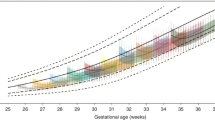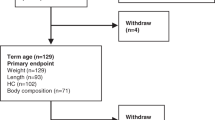Abstract
Normal fetal nutrition is a useful guide for understanding postnatal nutrition of infants born very preterm. Fetal lipid uptake gradually increases towards term and is primarily used to produce fat in adipose tissue, with essential fatty acid uptake providing necessary structural and functional elements in membranes of cells in the central nervous system. Fetal glucose uptake and utilization rates are nearly twice as high at 23–26 weeks gestation as they are at term, contributing primarily to energy production and glycogen formation. Amino-acid uptake by the fetus is two-to threefold greater at 23–26 weeks gestation than at term and is required to meet the very high fractional protein synthesis and growth rates at this gestational period; amino acids also contribute significantly to fetal energy production. In contrast, after birth most of the very preterm infants are fed more lipid and glucose and less amino acids and protein than they need. Not surprisingly, therefore, very preterm infants accumulate fat but remain relatively growth restricted at term gestational age compared to those infants who grew normally in utero, and this postnatal growth restriction has long-term adverse growth, development, and health consequences. More thorough understanding of the unique nutritional, metabolic, and growth requirements of the normally growing fetus and the very preterm infant, once born, are needed to determine optimal nutritional strategies to improve the outcome of preterm infants.
This is a preview of subscription content, access via your institution
Access options
Subscribe to this journal
Receive 12 print issues and online access
$259.00 per year
only $21.58 per issue
Buy this article
- Purchase on Springer Link
- Instant access to full article PDF
Prices may be subject to local taxes which are calculated during checkout
Similar content being viewed by others
References
American Academy of Pediatrics Committee on Nutrition. Nutritional needs of low-birth-weight infants. Pediatrics 1985; 76: 976–986.
Hay Jr WW . Nutrient delivery and metabolism in the fetus. In: Hod M, Jovanovic L, Di Renzo G, DeLeiva A (eds). Textbook of Diabetes and Pregnancy. Martin Dunitz, Ltd.: London and New York; 2003 pp 201–221.
Ehrenkranz RA . Growth outcomes of very low-birth weight infants in the newborn intensive care unit. Clin Perinatol 2000; 27: 325–345.
Hack M, Schlechter M, Cartar L, Rahman M, Cuttler L, Borawski E . Growth of very low birth weight infants to age 20 years. Pediatrics 2003; 112: e30–e38.
Lucas A, Morley RM, Cole TJ, Gore SM . A randomized multicenter study of human milk versus formula and later development in preterm infants. Arch Dis Child Fetal Neonatal Ed 1994; 70: F141–F146.
Milley JR . Ovine fetal leucine kinetics and protein metabolism during decreased oxygen availability. Am J Physiol 1998; 274: E618–E626.
Milley JR . Uptake of exogenous substrates during hypoxia in fetal lambs. Am J Physiol 1988; 254: E572–E578.
Groothuis JR, Rosenberg AA . Home oxygen promotes weight gain in infants with bronchopulmonary dysplasia. Am J Dis Child 1987; 141: 992–995.
Stockman II JA, Clark DA . Weight gain: a response to transfusion in the premature infant. Am J Dis Child 1984; 138: 831–833.
Tin W . Oxygen therapy: 50 years of uncertainty. Pediatrics 2002; 110: 615–616.
Alverson DC . The physiologic impact of anemia in the neonate. Clin Perinatol 1995; 22: 609–625.
Battaglia FC, Meschia G . Fetal nutrition. Annu Rev Nutr 1988; 8: 43–61.
Battaglia FC, Meschia G . An Introduction to Fetal Physiology. Academic Press, Inc.: Orlando; 1986 pp 100–135.
Molina RD, Meschia G, Battaglia FC, Hay Jr WW . Gestational maturation of placental glucose transfer capacity in sheep. Am J Physiol 1991; 261: R697–R704.
Sunehag A . The role of parenteral lipids in supporting gluconeogenesis in very premature infants. Pediatr Res 2003; 54: 480–486.
Carver TD, Quick Jr AN, Teng CC, Pike AW, Fennessey PV, Hay Jr WW . Leucine metabolism in chronically hypoglycemic, hypoinsulinemic growth restricted fetal sheep. Am J Physiol 1997; 272 (Endocrinol. Metab. 35): E107–E117.
Marconi AM, Paolini C, Buscaglia M, Zerbe G, Battaglia FC, Pardi G . The impact of gestational age and fetal growth on the maternal–fetal glucose concentration difference. Obstet Gynecol 1996; 87: 937–942.
Lucas A, Morley R, Cole TJ . Adverse neurodevelopmental outcome of moderate neonatal hypoglycemia. BMJ 1988; 297: 1304–1308.
Das UG, Schroeder RE, Hay Jr WW, Devaskar SU . Time-dependent and tissue-specific effects of circulating glucose on fetal ovine glucose transporters. Am J Physiol 1999; 276 (Regulatory Integrative Comp. Physiol. 45): R809–R817.
Aldoretta PW, Hay Jr WW . Chronic hyperglycemia induces insulin resistance and glucose intolerance in fetal sheep. Pediatr Res 2001; 49: 307A, No. 1758.
Carver TD, Anderson SM, Aldoretta PW, Esler AL, Hay Jr WW . Glucose suppression of insulin secretion in chronically hyperglycemic fetal sheep. Pediatr Res 1995; 38: 754–762.
Petersen KF, Dufour S, Befroy D, Garcia R, Shulman GI . Impaired mitochondrial activity in the insulin-resistant offspring of patients with type 2 diabetes. N Engl J Med 2004; 350: 664–671.
Limesand SW, Jensen J, Hutton JC, Hay Jr WW . Diminished β-cell replication contributes to reduced β-cell mass in fetal sheep with intrauterine growth restriction. Am J Physiol Reg Integr Comp Physiol 2005; 288: R1297–R1305, E-pub 2005 Jan 13.
Yau K, Chang M . Growth and body composition of preterm, small-for-gestational-age infants at a postmenstrual age of 37–40 weeks. Early Human Development 1993; 33: 117–131.
Sabita U, Thomas EL, Hamilton G, Doré CJ, Bell J, Modi N . Altered adiposity after extremely preterm birth. Pediatr Res 2005; 57: 211–215.
Sellmayer A, Koletzko B . Long-chain polyunsaturated fatty acids and eicosanoids in infants – Physiological and pathophysiological aspects and open questions. Lipids 1999; 34: 199–205.
Carlson SE, Werkman SH, Rhodes PG, Tolley EA . Visual acuity development in healthy preterm infants: effect of marine oil supplementation. Am J Clin Nutr 1993; 58: 35–42.
Hay Jr WW . Nutrition and development of the fetus: carbohydrate and lipid metabolism. In: Walker WA, Watkins JB, Duggan CP (eds). Nutrition in Pediatrics (Basic Science and Clinical Applications), 3rd edn. BC Decker Inc. Publisher: Hamilton, Ontario, Canada; 2003 pp 449–470.
Meier PR, Peterson RG, Bonds DR, Meschia G, Battaglia FC . Rates of protein synthesis and turnover in fetal life. Am J Physiol 1981; 240: E320–E324.
Ross JC, Fennessey PV, Wilkening RB, Battaglia FC, Meschia G . Placental transport and fetal utilization of leucine in a model of fetal growth retardation. Am J Physiol 1996; 270: E491–E503.
Ziegler EE . Protein in premature feeding. Nutrition 1994; 10: 69–71.
Woods LL, Ingelfinger JR, Nyengaard JR, Rasch R . Maternal protein restriction suppresses the newborn renin–angiotensin system and programs adult hypertension in rats. Pediatr Res 2001; 49: 460–467.
Petrik J, Reusens B, Arany E, Remacle C, Coelho C, Hoet JJ et al. A low protein diet alters the balance of islet cell replication and apoptosis in the fetal and neonatal rat and is associated with a reduced pancreatic expression of insulin-like growth factor-II. Endocrinology 1999; 140: 4861–4873.
Micheli JL, Schutz Y . Protein. In: Tsang RC, Lucas A, Uauy R, Zlotkin S (eds). Nutritional Needs of the Preterm Infant, Scientific Basis and Practical Guidelines. Caduceus Medical Publishers, Inc.: Pawling, NY; 1993 pp 29–46.
Zlotkin SH, Bryan MH, Anderson GH . Intravenous nitrogen and energy intakes required to duplicate in utero nitrogen accretion in prematurely born human infants. J Pediatr 1981; 99: 115–120.
Hay Jr WW, Regnault TRH . Fetal requirements and placental transfer of nitrogenous compounds. In: Polin RA, Fox WW, Abman SH (eds). Fetal and Neonatal Physiology, 3rd edn. W.B. Saunders Co.: Philadelphia; 2003 pp 509–527.
Heird WC, Hay Jr WW, Helms RA, Storm MC, Kashyap S, Bell RB . Pediatric parenteral amino acid mixture in low birth weight infants. Pediatrics 1988; 8l: 41–50.
Thureen PJ, Melara D, Fennessey PV, Hay Jr WW . Effect of low versus high intravenous amino acid intake on very low birth weight infants in the early neonatal period. Pediatr Res 2003; 53: 24–32.
Wahlig TM, Georgieff MK . The effects of illness on neonatal metabolism and nutritional management. Clin Perinatol 1995; 22: 77–96.
Billeaud C, Piedboeuf B, Chessex P . Energy expenditure and severity of respiratory disease in very low birth weight infants receiving long-term ventilatory support. J Pediatr 1992; 120: 461–464.
Mitchell IM, Davies PS, Day JM, Pollock JC, Jamieson MP . Energy expenditure in children with congenital heart disease, before and after cardiac surgery. J Thorac Cardiovasc Surg 1994; 197: 374–380.
Fitzgerald MJ, Goto M, Myers TF, Zeller WP . Early metabolic effects of sepsis in the preterm infant: lactic acidosis and increased glucose requirement. J Pediatr 1992; 121: 951–955.
Milley JR . Ovine fetal metabolism during norepinephrine infusion. Am J Physiol 1997; 273: E336–E347.
Papile LA, Tyson JE, Stoll BJ, Wright LL, Donovan EF, Bauer CR et al. A multicenter trial of two dexamethasone regimens in ventilator-dependent premature infants. N Engl J Med 1998; 338: 1112–1118.
Thureen PJ, Scheer B, Anderson SM, Hay Jr WW . Effect of hyperinsulinemia on amino acid utilization in the ovine fetus. Am J Physiol 2000; 279, (Endocrinol. Metab.) E1294–E1304.
Smart JL . Critical periods in brain development. In: Bock GR, Whelan J (eds). The Childhood Environment and Adult Disease. CIBA Foundation Symposium 156: Chichester, Wiley; 1991 pp 109–128.
Carlson SJ, Ziegler EE . Nutrient intakes and growth of very low birth weight infants. J Perinatol 1998; 18: 252–258.
Singhal A, Fewtrell M, Cole TJ, Lucas A . Low nutrient intake and early growth for later insulin resistance in adolescents born preterm. The Lancet 2003; 361: 1089–1097.
Cianfarani S, Germani D, Branca F . Low birthweight and adult insulin resistance: the ‘catch-up growth’ hypothesis. Arch Dis Child Fetal Neoanatal Ed 1999; 81: F71–F73.
Lucas A, Morley R, Cole TJ . Randomised trial of early diet in preterm babies and later intelligence quotient. BMJ 1998; 317: 1481–1487.
Acknowledgements
This work was supported by grants from the National Institutes of Health: M01RR00069 (WWH, Associate Director); RO1 HD42815 (WWH, PI); RO1 HD28794 (WWH, PI); RO1 DK52138 (WWH, PI); T32 HD07186 (WWH, PI).
Author information
Authors and Affiliations
Corresponding author
Rights and permissions
About this article
Cite this article
Hay, W. Early postnatal nutritional requirements of the very preterm infant based on a presentation at the NICHD-AAP workshop on research in neonatology. J Perinatol 26 (Suppl 2), S13–S18 (2006). https://doi.org/10.1038/sj.jp.7211426
Published:
Issue Date:
DOI: https://doi.org/10.1038/sj.jp.7211426
Keywords
This article is cited by
-
ELBW infants receive inadvertent sodium load above the recommended intake
Pediatric Research (2020)
-
Blood urea nitrogen and serum bicarbonate in extremely low birth weight infants receiving higher protein intake in the first week after birth
Journal of Perinatology (2011)
-
Improved growth and decreased morbidities in <1000 g neonates after early management changes
Journal of Perinatology (2008)
-
Multivariate analysis of hyperglycemia in extremely low birth weight infants
Journal of Perinatology (2006)



